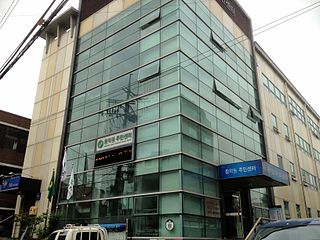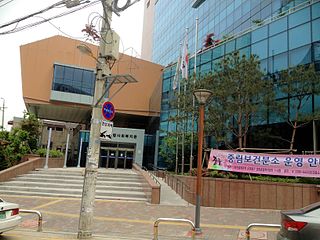
Sogong-dong is a dong of Jung-gu district in Seoul, South Korea.

Hwanghak-dong is a dong (neighborhood) of Jung District, Seoul, South Korea.

Gwanghui-dong is a dong (neighborhood) of Jung District, Seoul, South Korea.

Hoehyeon-dong is a dong (neighborhood) of Jung District, Seoul, South Korea.

Jungnim-dong is a dong, neighbourhood of Jung-gu in Seoul, South Korea.
Bangsan-dong (Korean: 방산동) is a legal dong, or neighborhood, of Jung District, Seoul, South Korea and governed by its administrative dong, Euljiro 3, 4, 5ga-dong.

Da-dong is a legal dong (neighborhood) of Jung District, Seoul, South Korea. It is governed by its administrative dong, Myeong-dong.
Cho-dong (Korean: 초동) is a legal dong (neighborhood) of Jung District, Seoul, South Korea. It is governed by its administrative dong, Euljiro 3, 4, 5-dong.
Ipjeong-dong is a legal dong, or neighbourhood of the Jung-gu district in Seoul, South Korea and governed by its administrative dong, Euljiro 3, 4, 5ga-dong.
Jeong-dong is a legal dong, or neighbourhood of the Jung-gu district in Seoul, South Korea and governed by its administrative dong, Sogong-dong.
Jeo-dong is a legal dong, or neighbourhood of the Jung-gu district in Seoul, South Korea and governed by its administrative dong, Myeong-dong and Euljiro 3, 4, 5ga-dong.
Jugyo-dong is a legal dong, or neighbourhood of the Jung-gu district in Seoul, South Korea. It is governed by its administrative dong, Euljiro 3, 4, 5ga-dong.
Juja-dong is a legal dong, or neighbourhood of the Jung-gu district in Seoul, South Korea and governed by its administrative dong, Pil-dong.
Muhak-dong is a legal dong, or neighbourhood of the Jung-gu district in Seoul, South Korea and governed by its administrative dong, Sindang 1-dong.
Seosomun-dong is a legal dong, or neighbourhood of the Jung-gu district in Seoul, South Korea and governed by its administrative dong, Sogong-dong.
Samgak-dong is a legal dong, or neighbourhood of the Jung-gu district in Seoul, South Korea and governed by its administrative dong, Myeong-dong.
Namsan-dong is a legal dong, or neighbourhood of the Jung-gu district in Seoul, South Korea and governed by its administrative dong, Myeong-dong.
Namchang-dong is a legal dong, or neighbourhood of the Jung-gu district in Seoul, South Korea and governed by its administrative dong, Hoehyeon-dong.
Namhak-dong is a legal dong, or neighbourhood of the Jung-gu district in Seoul, South Korea and governed by its administrative dong, Pil-dong.
Suha-dong is a legal dong, or neighbourhood of the Jung-gu district in Seoul, South Korea and governed by its administrative dong, Myeong-dong.








